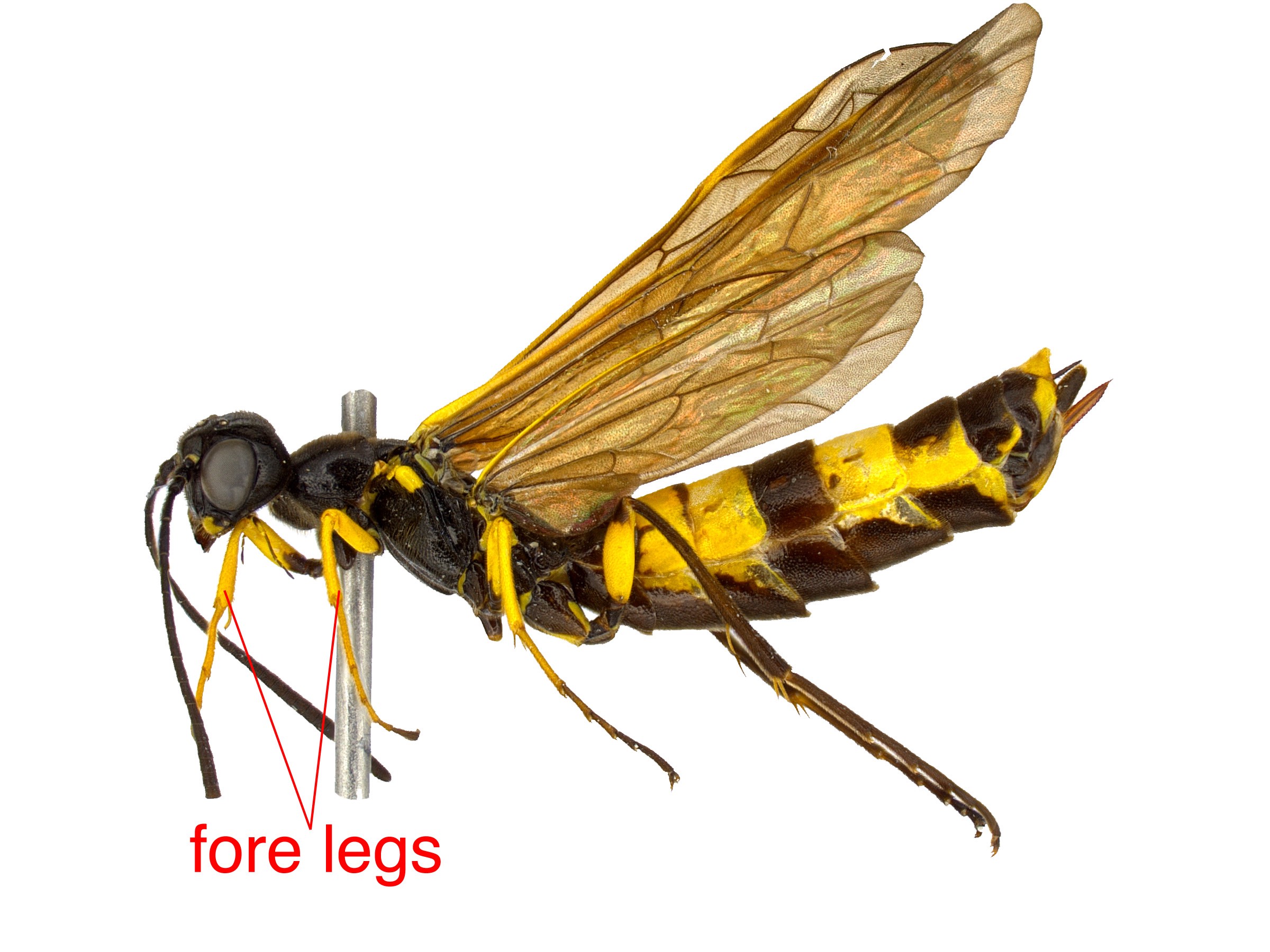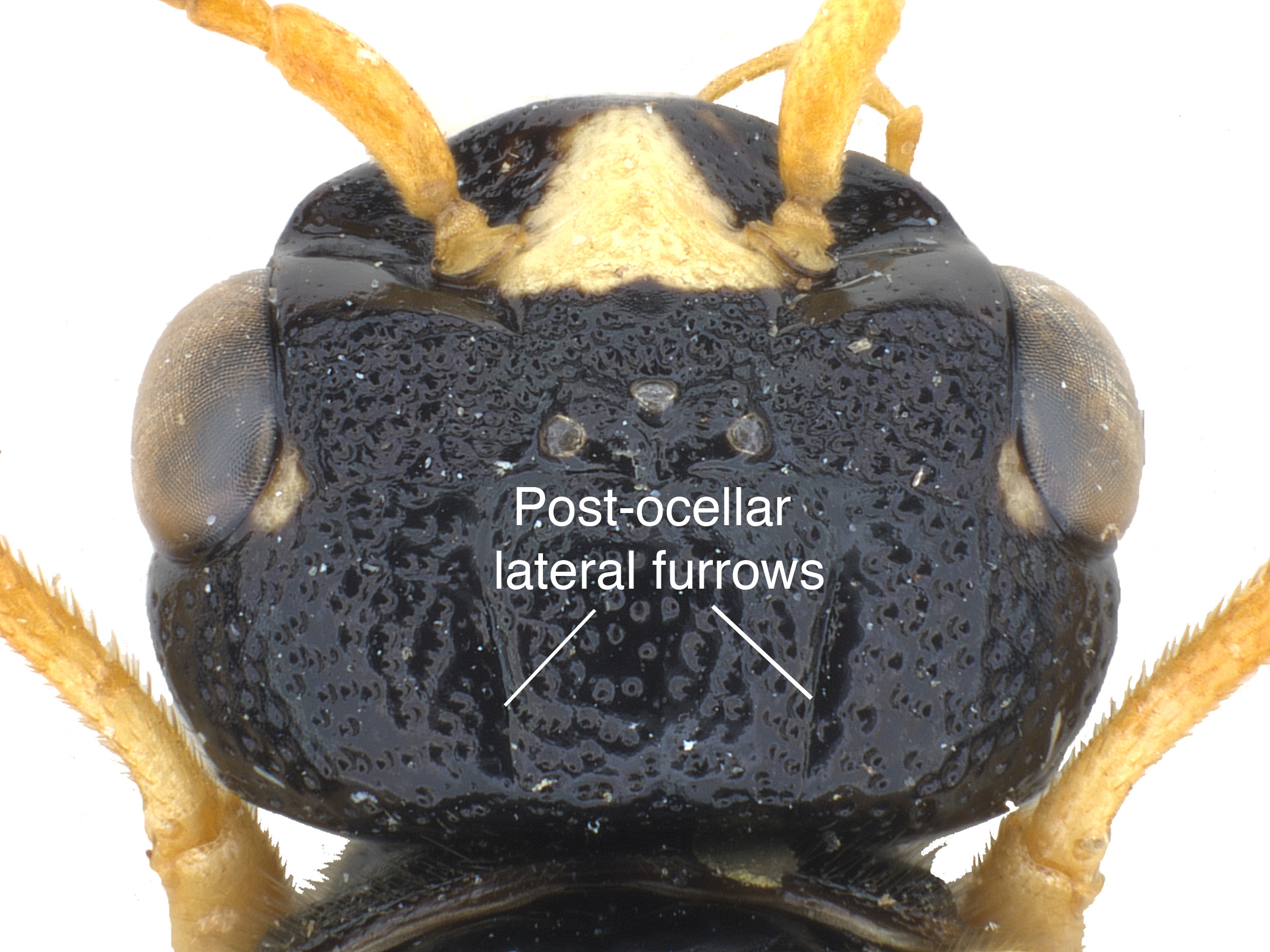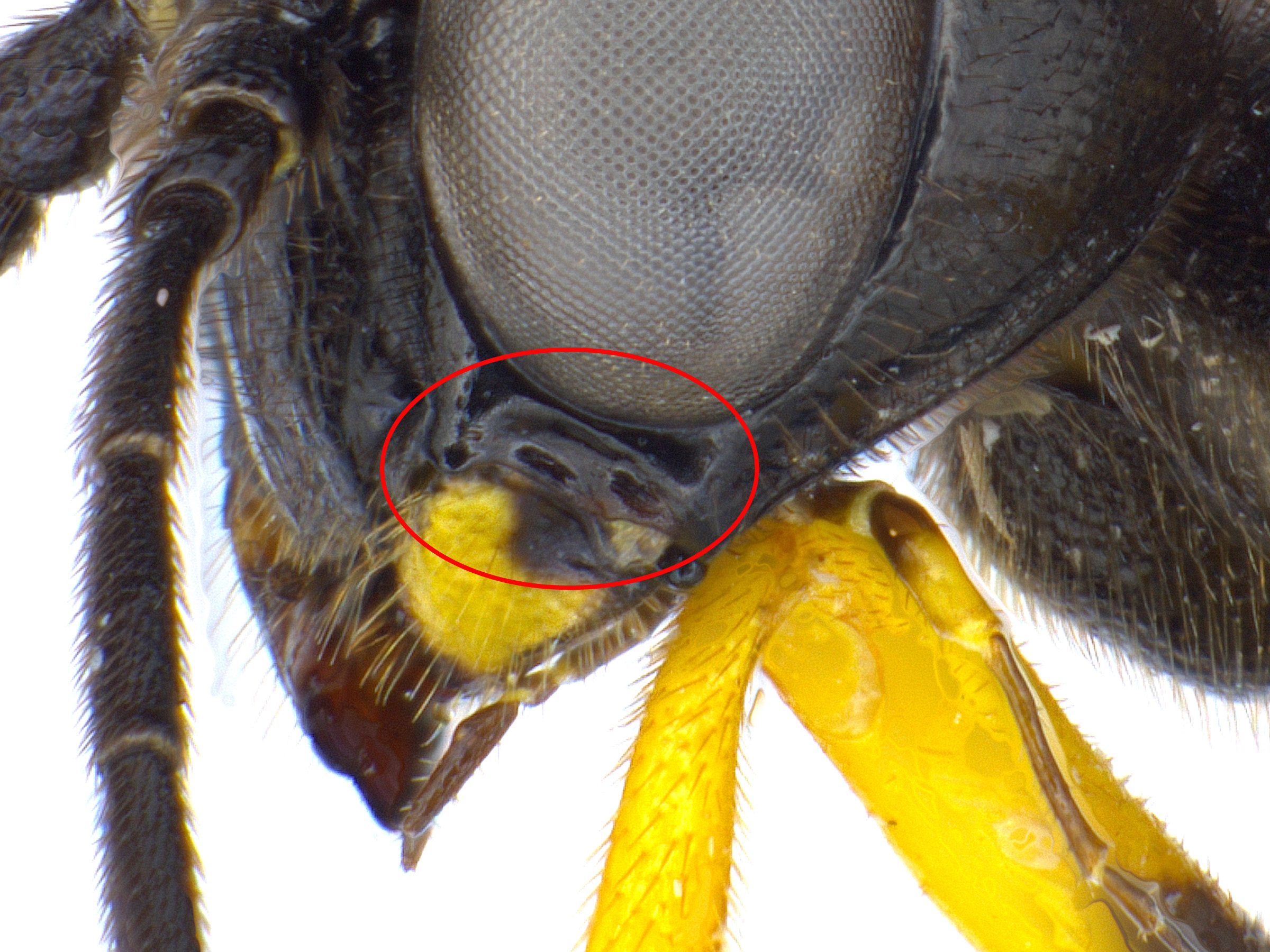Family: Pamphiliidae
Family common name: web-spinning and leaf-rolling sawflies
Subfamily: Pamphiliinae
Tribe: Pamphiliini
Genus: Pamphilius Latreille, 1803
Subgenera: none
The Pamphiliidae are called the web-spinning and leaf-rolling sawflies because of their shelter-building behavior as larvaelarva:
the immature stage of holometabolous insects
 .
.
The speciosespeciose:
describing a taxon that includes a high number of species
genus Pamphilus is a leaf-roller of a variety of hosts. LarvaeLarva:
the immature stage of holometabolous insects
 create rolled tubes of leaf matter and silk to live inside of for protection. The leaf rolls are fairly distinctive, and some species can be recognized by their tube morphology (Middlekauff 1964Middlekauff 1964:
create rolled tubes of leaf matter and silk to live inside of for protection. The leaf rolls are fairly distinctive, and some species can be recognized by their tube morphology (Middlekauff 1964Middlekauff 1964:
Middlekauff WW. 1964. The North American sawflies of the genus Pamphilius (Hymenoptera: Pamphiliidae). University of California Publications in Entomology 38: 1-80.).
There are 122 described species worldwide, all restricted to the Northern Hemisphere. Eighteen species occur in North America, including one introduced (Taeger et al. 2010Taeger et al. 2010:
Taeger A, Blank SM, and Liston AD. 2010. World Catalog of Symphyta (Hymenoptera). Zootaxa 2580: 1-1064.).
A key to North American species of Pamphilius is included in Middlekauff 1964Middlekauff 1964:
Middlekauff WW. 1964. The North American sawflies of the genus Pamphilius (Hymenoptera: Pamphiliidae). University of California Publications in Entomology 38: 1-80..
 from above slightly constricted, without two distinct faces, more or less evenly flat from the dorsum to the anterioranterior:
from above slightly constricted, without two distinct faces, more or less evenly flat from the dorsum to the anterioranterior: with 2 apicalapical:
with 2 apicalapical: with 3–4 preapicalpreapical:
with 3–4 preapicalpreapical: tibial spurs (Goulet 1992Goulet 1992:
tibial spurs (Goulet 1992Goulet 1992: width at basebase:
width at basebase: with either large inner tooth, close to the apexapex:
with either large inner tooth, close to the apexapex: membrane wrinkled horizontally at the apexapex:
membrane wrinkled horizontally at the apexapex: behind the compound eye clearly outlined (Goulet 1992Goulet 1992:
behind the compound eye clearly outlined (Goulet 1992Goulet 1992: Sc1 of the fore wingfore wing:
Sc1 of the fore wingfore wing: present and well-developed (Goulet 1992Goulet 1992:
present and well-developed (Goulet 1992Goulet 1992: more or less flat, sometimes with straight, non-hooked setaeseta:
more or less flat, sometimes with straight, non-hooked setaeseta:Pamphiliidae are recognized by a somewhat large quadratequadrate:
square-like or cube-like in shape
 head, elongate filform antennaeantenna:
head, elongate filform antennaeantenna:
the sensory organ emerging from the front of the head, usually between the compound eyes and above the clypeus; includes the flagellum, scape and pedicel
 , and tarsal claws often with inner teeth. Pamphilius can be distinguished from Onycholyda by the absence of hooked setaeseta:
, and tarsal claws often with inner teeth. Pamphilius can be distinguished from Onycholyda by the absence of hooked setaeseta:
hair-like structure
in the malar spacemalar space:
the minimum distance between the base of the mandible and the ventral margin of the compound eye
 , and from other genera by the presence of fore wingfore wing:
, and from other genera by the presence of fore wingfore wing:
the anterior wing of each pair of wings; usually the largest wing of the pair
 vein Sc1 and the tarsal clawtarsal claw:
vein Sc1 and the tarsal clawtarsal claw:
sharpened appendage emerging from the apex of the tarsus
 shape (Goulet 1992Goulet 1992:
shape (Goulet 1992Goulet 1992:
Goulet H. 1992. The genera and subgenera of the sawflies of Canada and Alaska: Hymenoptera. Symphyta. The insects and arachnids of Canada. Part 20. Agriculture Canada Publication.).
One sawfly introduced to North America from central Asia, P. persicum, is recorded as a defoliating pest of Prunus persica (peach) trees in orchards in the early twentieth century (Walden 1907Walden 1907:
Walden BH. 1907. Notes on a new sawfly attacking the peach.( Pamphilius persicum Mac G.). USDA Bureau of Entomology Bulletin 67: 85-86., Shinohara 1985bShinohara 1985b:
Shinohara A. 1985b. Web-spinning sawflies of the sylvaticus-group of Pamphilius (Hymenoptera: Pamphiliidae). Systematic Entomology 10: 323-351.). Recently, however, no significant outbreaks resulting in high levels of damage have been reported.
Larvae in North America feed on foliage of deciduousdeciduous:
describing a tree that drops its foliage once a year and then re-grows it; often senescence occurs before winter and re-growth occurs in the spring
tree and shrub species of several families. Rosaceae hosts include species from: Amelanchier (serviceberry), Rubus (blackberry), Prunus (cherry, plum, peach), Malus (apple), and Rosa (rose). Hosts from other angiosperm families include species from: Cornuscornus:
a pointed horn-like process on the apical end of the abdomen in Siricidae sawflies; on tergite 10 in females, sternite 9 in males
 (dogwood), Corylus (hazel), Populus (cottonwood), Quercus (oak), Salix (willow), Betula (birch), Fagus (beech), and Viburnum (Middlekauff 1964Middlekauff 1964:
(dogwood), Corylus (hazel), Populus (cottonwood), Quercus (oak), Salix (willow), Betula (birch), Fagus (beech), and Viburnum (Middlekauff 1964Middlekauff 1964:
Middlekauff WW. 1964. The North American sawflies of the genus Pamphilius (Hymenoptera: Pamphiliidae). University of California Publications in Entomology 38: 1-80.).
Females oviposit eggs, singly or in groups of up to 12, on the underside of leaves alongside a veinvein:
a tube-like, often darkened, structure on the wings
 . Eggs are slightly cylindrical and white. After hatching, the larvalarva:
. Eggs are slightly cylindrical and white. After hatching, the larvalarva:
the immature stage of holometabolous insects
 begins to roll the leaf into a tube-shaped nest. The leaf-tube shape varies across species and may be cone-shaped, corkscrew-shaped or comprising several leaves clumped together. In all cases, silk is used to cinch the leaf in the preferred position and hold the tube together. The larvaelarva:
begins to roll the leaf into a tube-shaped nest. The leaf-tube shape varies across species and may be cone-shaped, corkscrew-shaped or comprising several leaves clumped together. In all cases, silk is used to cinch the leaf in the preferred position and hold the tube together. The larvaelarva:
the immature stage of holometabolous insects
 generally do not use thoracicthoracic:
generally do not use thoracicthoracic:
of or on the thorax
legs for locomotion and instead use strands of silk to pull their body along a surface, or inch along like a worm. Mature larvaelarva:
the immature stage of holometabolous insects
 fall to the ground and burrow into the soil at a depth of 2–6 inches where they press surrounding soil into a cellcell:
fall to the ground and burrow into the soil at a depth of 2–6 inches where they press surrounding soil into a cellcell:
1. a membranous area of the wing between veins, 2. a small cavity or closed space
 and overwinter. Pupation and emergence occur in the spring (Middlekauff 1964Middlekauff 1964:
and overwinter. Pupation and emergence occur in the spring (Middlekauff 1964Middlekauff 1964:
Middlekauff WW. 1964. The North American sawflies of the genus Pamphilius (Hymenoptera: Pamphiliidae). University of California Publications in Entomology 38: 1-80., Shinohara and Byun 1993Shinohara and Byun 1993:
Shinohara A and Byun BK. 1993. Pamphiliid sawfly genera Neurotoma and Onycholyda (Hymenoptera, Symphyta) of Korea. Ins. Koreana 10: 75-91.).
Adults fly on sunny days during the spring and summer. Some adults may feed on pollen and have been observed visiting flowers of strawberry. Pamphilius is generally univoltineunivoltine:
describing an insect with a life cycle of one generation per year
, although there are records of an occasional two-year life cycle (Middlekauff 1964Middlekauff 1964:
Middlekauff WW. 1964. The North American sawflies of the genus Pamphilius (Hymenoptera: Pamphiliidae). University of California Publications in Entomology 38: 1-80.).
World: The genus is widespread and common from central Europe and Scandinavia, east to Siberia, and also occurs in Asia (Van Achterberg and Van Aartsen 1986Van Achterberg and Van Aartsen 1986:
Van Achterberg C and Van Aartsen B. 1986. The European Pamphiliidae (Hymenoptera: Symphyta), with special reference to the Netherlands. Zoologische Verhandelingen 234: 3-98.).
North America: Pamphilius are known from forested regions, generally the United States Northwest, Northeast, and Southeast, and throughout southern Canada, as far north as Alaska (Middlekauff 1964Middlekauff 1964:
Middlekauff WW. 1964. The North American sawflies of the genus Pamphilius (Hymenoptera: Pamphiliidae). University of California Publications in Entomology 38: 1-80., Lindquist and Harnden 1970Lindquist and Harnden 1970:
Lindquist PH and Harnden AA. 1970. A study of the biology of the web-spinning sawfly Pamphilius ochreipes (Hymenoptera: Pamphiliidae) in Ontario. The Canadian Entomologist 102: 95-97.).
Map data from: GBIF.org (26 June 2019) GBIF Occurrence Download Pamphilius
Details about data used for maps can be found here.